Brazil nut
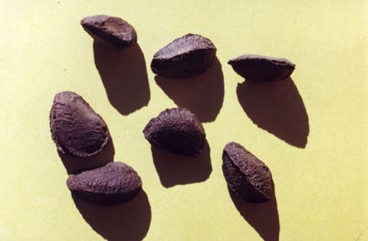
A tropical plant. It requires a hot, humid tropical lowland climates. It grows naturally in areas with an average temperature of 24-27°C. It needs a minimum annual temperature of 20-23°C and a maximum of 30-33°C. The rainfall is 1400-2800 mm per year. The annual average humidity is between 79-91%. It is damaged by drought and frost. It suits hardiness zone 12.
Also known as:
Almendro, Castana del Brasil, Castana, Castanha-do-para, Castanheira, Castanheiro do Para, Chataigne du bresil, Coquito del Brasil, Niggertoe, Nuez del Brazil, Para nut, Paranoot, Tapa, Tapa risti, Tsixo
Synonyms
- Bertholletia nobilis Miers
- Berthollesia excelsa Silva Manso
Edible Portion
- Nuts, Oil, Flavouring, Seeds - oil
Where does Brazil nut grow?
Found in: Africa, Amazon, Asia, Australia, Bolivia, Brazil, Cameroon, Central Africa, Central America, China, Colombia, Costa Rica, Cuba, Ecuador, India, Ghana, Guiana, Guianas, Guyana, Malaysia, Peru, SE Asia, Singapore, South America, Suriname, Trinidad, Venezuela, West Africa
Notes: There is only one Bertholettia species. Nuts have a high level of selenium. They are also high in sulphur containing amino acids. Selenium is helpful in preventing cancer. The charcoal from Brazil nut shells is good at purifying water.
Growing Brazil nut
Cultivation: The flowers are self sterile so a group of trees need to be planted near each other. Plants are grown from seed, cuttings or grafts. The seeds need to have the hard shell broken to help them to germinate. Seeds can only be stored for about 4-5 months. Because of the hard seed coat, seed may take 6-16 months to germinate. Treating seed by removing the seed coat and treating with phenyl mercuric acetate allows seeds to germinate in 3 months. Early germination can also be achieved by putting the nuts into sand a container with moist sand and storing it in a dry shady place for 6 months then removing the hard shell and planting the seeds.
Edible Uses: The nuts can be eaten raw or roasted. They are also salted and are used in ice cream. They are also sometimes grated with the stilt roots of Socratea palms and added to cassava flour. An oil can be extracted from the seeds.
Production: Trees grow very slowly. They begin producing nuts 8-10 years after planting. The fruit take over one year (14-15 months) to ripen. One tree can produce 300 or more pods per year. One fruit can weigh 2.2 kg. The nuts are harvested when the fruit fall to the ground.
Nutrition Info
per 100g edible portion| Edible Part | Energy (kcal) | Protein (g) | Iron (mg) | Vitamin A (ug) | Vitamin c (mg) | Zinc (mg) | % Water |
|---|---|---|---|---|---|---|---|
| Nuts | 609 | 12 | 2.8 | 0 | Tr | 4.2 | 8.5 |
| Seed - oil | - | - | - | - | - | - |
Brazil nut Photos

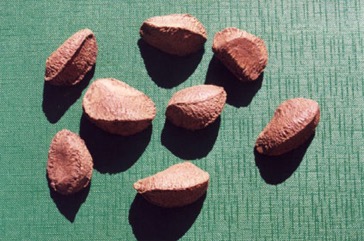
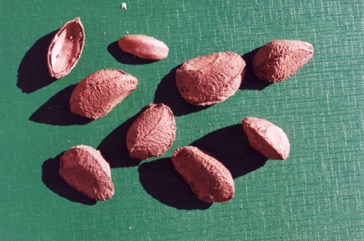
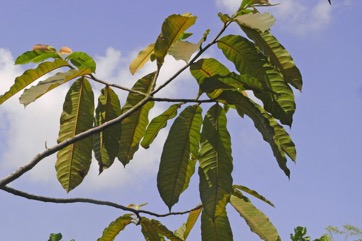
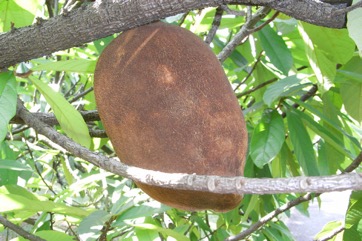
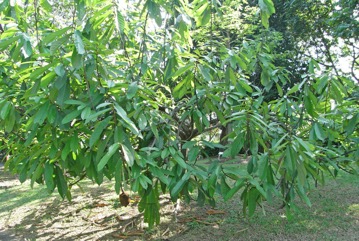
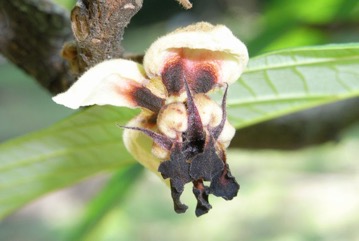
References
Abbiw, D.K., 1990, Useful Plants of Ghana. West African uses of wild and cultivated plants. Intermediate Technology Publications and the Royal Botanic Gardens, Kew. p 42
Altschul, S.V.R., 1973, Drugs and Foods from Little-known Plants. Notes in Harvard University Herbaria. Harvard Univ. Press. Massachusetts. no. 3026
Ambasta S.P. (Ed.), 2000, The Useful Plants of India. CSIR India. p 72
Andrade, E. H. A. et al, 1999, Seed Composition of Amazonian Lecythidaceae Species: Part 3 in the Series ‘‘Studies of Edible Amazonian Plants’’. Journal of Food Composition and Analysis 12:37-51
Barwick, M., 2004, Tropical and Subtropical Trees. A Worldwide Encyclopedic Guide. Thames and Hudson p 50
Bianchini, F., Corbetta, F., and Pistoia, M., 1975, Fruits of the Earth. Cassell. p 194
Bircher, A. G. & Bircher, W. H., 2000, Encyclopedia of Fruit Trees and Edible Flowering Plants in Egypt and the Subtropics. AUC Press. p 58 (Also as Bertholettia nobilis)
Bodkin, F., 1991, Encyclopedia Botanica. Cornstalk publishing, p 143
Brouk, B., 1975, Plants Consumed by Man. Academic Press, London. p 212
Burkill, I.H., 1966, A Dictionary of the Economic Products of the Malay Peninsula. Ministry of Agriculture and Cooperatives, Kuala Lumpur, Malaysia. Vol 1 (A-H) p 322
Chin, H.F., & Yong, H.S., 1996, Malaysian Fruits in Colour. Tropical press, Kuala Lumpur p 87
Darley, J.J., 1993, Know and Enjoy Tropical Fruit. P & S Publishers. p 75
Etkin, N.L. (Ed.), 1994, Eating on the Wild Side, Univ. of Arizona. p 122, 136
Facciola, S., 1998, Cornucopia 2: a Source Book of Edible Plants. Kampong Publications, p 140
FAO, 1995, Edible Nuts. Non Wood Forest Products 5.
Flowerdew, B., 2000, Complete Fruit Book. Kyle Cathie Ltd., London. p 206
Gouldstone, S., 1978, Australian and New Zealand Guide to food bearing plants. Books for Pleasure. p 44
Grandtner, M. M. & Chevrette, J., 2013, Dictionary of Trees, Volume 2: South America: Nomenclature, Taxonomy and Ecology. Academic Press p 65
Hedrick, U.P., 1919, (Ed.), Sturtevant's edible plants of the world. p 100
Hermandez Bermejo, J.E., and Leon, J. (Eds.), 1994, Neglected Crops. 1492 from a different perspective. FAO Plant Production and Protection Series No 26. FAO, Rome. p 15
Heywood, V.H., Brummitt, R.K., Culham, A., and Seberg, O. 2007, Flowering Plant Families of the World. Royal Botanical Gardens, Kew. p 183
F. W. H. A. Humboldt & A. J. A. Bonpland, Pl. aequinoct. 1:122-127, t. 36. 1807
Hu, Shiu-ying, 2005, Food Plants of China. The Chinese University Press. p 573
Hunter, D., et al, 2019, The potential of neglected and underutilized species for improving diets and nutrition. Planta (2019) 250:709-729
Kiple, K.F. & Ornelas, K.C., (eds), 2000, The Cambridge World History of Food. CUP p 1737
Lorenzi, H., 2002, Brazilian Trees. A Guide to the Identification and Cultivation of Brazilian Native Trees. Vol. 01 Nova Odessa, SP, Instituto Plantarum p 149
Lorenzi, H., Bacher, L., Lacerda, M. & Sartori, S., 2006, Brazilian Fruits & Cultivated Exotics. Sao Paulo, Instituto Plantarum de Estuados da Flora Ltda. p 154
Macmillan, H.F. (Revised Barlow, H.S., et al) 1991, Tropical Planting and Gardening. Sixth edition. Malayan Nature Society. Kuala Lumpur. p 271
Martin, F. W., et al, 1987, Perennial Edible Fruits of the Tropics. USDA Handbook 642 p 32
Menninger, E.A., 1977, Edible Nuts of the World. Horticultural Books. Florida p 34
Milow, P., et al, 2013, Malaysian species of plants with edible fruits or seeds and their evaluation. International Journal of Fruit Science. 14:1, 1-27
Mulherin, J., 1994, Spices and natural flavourings. Tiger Books, London. p 111
O'Malley, D.M., et al, Genetics of Brazil nut (Bertholletia excelsa Humb. & Bonpl.: Lecythidaceae) Theor. Appl. Genetic. (1988) 76:929-932
Paz, F. S., et al, 2021, Edible Fruit Plant Species in the Amazon Forest Rely Mostly on Bees and Beetles as Pollinators. Journal of Economic Entomology, XX(XX), 2021, 1–13
Philips, O., 1992, The potential for harvesting fruits in tropical rainforests: new data from Amazonian Peru. Biodiversity and Conservation 2, 18-38
Purseglove, J.W., 1968, Tropical Crops Dicotyledons, Longmans. p 637
Schuler, S., (Ed.), 1977, Simon & Schuster's Guide to Trees. Simon & Schuster. No. 186
Shanley, P. et al, (Eds), 2011, Fruit trees and useful plants in Amazonian life. Non-wood Forest Products No 20. FAO, CIFOR and PPI. p 49
Small, E., 2009, Top 100 Food Plants. The world's most important culinary crops. NRC Research Press. p 131
USDA, ARS, National Genetic Resources Program. Germplasm Resources Information Network - (GRIN). [Online Database] National Germplasm Resources Laboratory, Beltsville, Maryland. Available: www.ars-grin.gov/cgi-bin/npgs/html/econ.pl (10 April 2000)
van Roosmalen, M.G.M., 1985, Fruits of the Guianan Flora. Utrecht Univ. & Wageningen Univ. p 162
van Wyk, B., 2005, Food Plants of the World. An illustrated guide. Timber press. p 86
Vasquez, R. and Gentry, A. H., 1989, Use and Misuse of Forest-harvested Fruits in the Iquitos Area. Conservation Biology 3(4): 350f
Verheij, E. W. M. and Coronel, R.E., (Eds.), 1991, Plant Resources of South-East Asia. PROSEA No 2. Edible fruits and nuts. Pudoc Wageningen. p 320
Villachica, H., (Ed.), 1996, Frutales Y hortalizas promisorios de la Amazonia. FAO, Lima. p 87
Wickens, G.E., 1995, Edible Nuts. FAO Non-wood forest products. FAO, Rome. p 28, 139
Williams, C.N., Chew, W.Y., and Rajartnam, J.A., 1989, Tree and Field Crops of the Wetter Regions of the Tropics. Longman, p 118
World Checklist of Useful Plant Species 2020. Royal Botanic Gardens, Kew
www.colecionandofrutas.org
www.worldagroforestrycentre.org/treedb/
Zambrana, P, et al, 2017, Traditional knowledge hiding in plain sight – twenty-first century ethnobotany of the Chácobo in Beni, Bolivia. Journal of Ethnobiology and Ethnomedicine (2017) 13:57